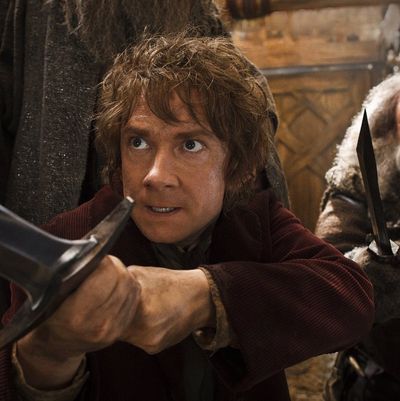
It didn’t seem like he’d be able to pull it off. After the calamitous disappointment of last year’s The Hobbit: An Unexpected Journey – which for all its box-office success seemed to drown in self-important bloat and endless narrative wheel-spinning – it didn’t seem as if Peter Jackson would be able to recover, to deliver an entertaining follow-up that did any kind of justice to J.R.R. Tolkien’s lively, brisk, and funny original. Much of the bloat is still there, but The Desolation of Smaug, the second film in the Hobbit trilogy, is a real improvement – filled with inventive action set pieces and dramatic face-offs that we (finally, at long last, hallelujah!) care about.
The new film begins where the last one left off, with our hero Bilbo Baggins (Martin Freeman) and his dwarf companions on their seemingly interminable journey to reclaim the Lonely Mountain, once the seat of dwarf power and now presided over by a hideous dragon named Smaug. Actually, right before he picks up the story, Jackson gives us one expository flashback, involving the wizard Gandalf (Ian McKellen) and the exiled dwarf-king Thorin Oakenshield (Richard Armitage) that summarizes and clarifies the confusing motivations of the first film. In fact, you could now probably get away with cutting (or ignoring) the entirety of An Unexpected Journey. You’d miss the pretty good Gollum scenes, but I’m not sure you’d lose anything all that crucial to the story itself.
Tolkien’s compact fable is still not well served by Jackson’s grandiose approach, but at least here he has some fun with his set pieces. There’s a gruesome giant spider attack, which is choreographed like an elaborate, breathtaking dance routine, proving the director still retains his perverse horror showman side. One of the joys of the original Lord of the Rings films was in watching how this onetime indie schlockmaster used the bigger budget and the broader canvas to let his twisted imagination take full flight. One of the disappointments of the first Hobbit was in seeing how much that imagination had been larded up with portent and pomposity.
I’m not all that well-versed in the Tolkien canon (The Hobbit is the only one of his books I genuinely like, and I’ve stayed far away from The Silmarillion), but Jackson & Co. seem to have taken more liberties this time around. Most significant, they’ve added a romantic-action subplot involving one of the dwarves and Tauriel (Evangeline Lily), a beautiful Elf warrior. This subplot also brings back Legolas (Orlando Bloom), a fan favorite from The Lord of the Rings who is not in Tolkien’s Hobbit book. It’s a mixed bag: On his own, Legolas is not particularly interesting, devoid of much adversity or character; what made his scenes in the Rings films work was his fun, combative back-and-forth with the dwarf warrior Gimli. But Tauriel, the lovestruck warrior, is compelling, not to mention a much-needed female presence who actually does something. You wish Jackson had had the foresight to make her the focus of the action and not bother with giving her a (superior) male cohort. How great would it have been if she’d had ass-kicking duties all to herself?
But the real fireworks in The Desolation of Smaug come in the final act, with the much anticipated face-off between Bilbo and Smaug (voiced by Freeman’s ubiquitous Sherlock co-star Benedict Cumberbatch). It’s everything you hoped it would be: fun and menacing and unbelievably tense, with Bilbo breathlessly showering the preening dragon with overwrought praise while the haughty monster slithers and slides among cascading mountains of gold, eager to kill this strange new creature but unable to resist the appeals to his vanity. (This part is straight out of Tolkien, of course, and yet another reminder that The Hobbit remains an excellent book.)
So, everything is better this time around, but you still can’t help but notice all the filler, the clumsy exposition, and graceless myth-making. We should never dream about what the movie we’re watching could have been, but it’s really hard not to with these Hobbit movies. In part, the problem might be this: The Lord of the Rings was a quest narrative and a road story, and so its length worked in its favor. The Hobbit, on the other hand, might be better thought of as a heist story. And heist stories require efficiency, propulsion, and clarity. But try telling that to Jackson, who may be living in his own Lonely Mountain, too busy exulting in his box-office receipts and surrounded by kowtowing yes-men to notice. Nevertheless, he wins this round: I never thought I’d say it, but I’m looking forward to the third Hobbit movie.


